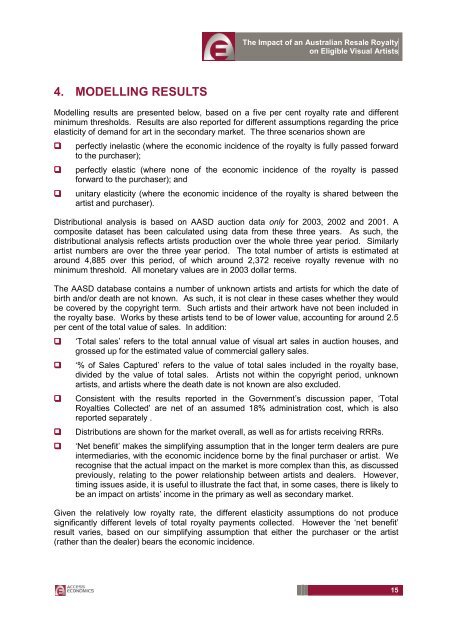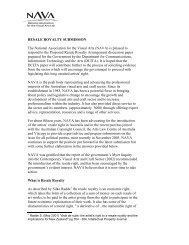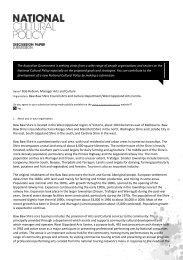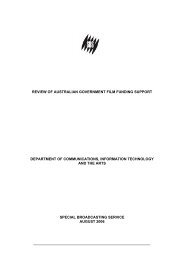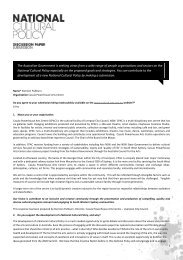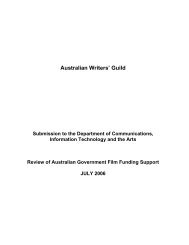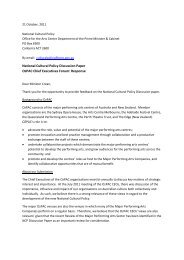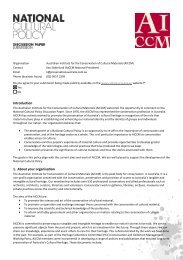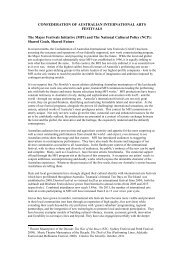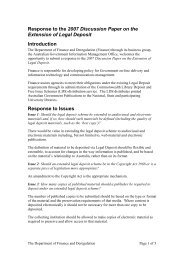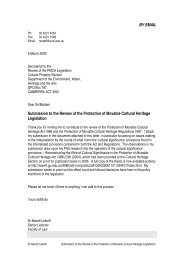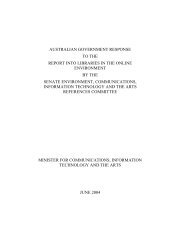evaluating the impact of an australian resale ... - Office for the Arts
evaluating the impact of an australian resale ... - Office for the Arts
evaluating the impact of an australian resale ... - Office for the Arts
Create successful ePaper yourself
Turn your PDF publications into a flip-book with our unique Google optimized e-Paper software.
The Impact <strong>of</strong> <strong>an</strong> Australi<strong>an</strong> Resale Royaltyon Eligible Visual Artists4. MODELLING RESULTSModelling results are presented below, based on a five per cent royalty rate <strong>an</strong>d differentminimum thresholds. Results are also reported <strong>for</strong> different assumptions regarding <strong>the</strong> priceelasticity <strong>of</strong> dem<strong>an</strong>d <strong>for</strong> art in <strong>the</strong> secondary market. The three scenarios shown areperfectly inelastic (where <strong>the</strong> economic incidence <strong>of</strong> <strong>the</strong> royalty is fully passed <strong>for</strong>wardto <strong>the</strong> purchaser);perfectly elastic (where none <strong>of</strong> <strong>the</strong> economic incidence <strong>of</strong> <strong>the</strong> royalty is passed<strong>for</strong>ward to <strong>the</strong> purchaser); <strong>an</strong>dunitary elasticity (where <strong>the</strong> economic incidence <strong>of</strong> <strong>the</strong> royalty is shared between <strong>the</strong>artist <strong>an</strong>d purchaser).Distributional <strong>an</strong>alysis is based on AASD auction data only <strong>for</strong> 2003, 2002 <strong>an</strong>d 2001. Acomposite dataset has been calculated using data from <strong>the</strong>se three years. As such, <strong>the</strong>distributional <strong>an</strong>alysis reflects artists production over <strong>the</strong> whole three year period. Similarlyartist numbers are over <strong>the</strong> three year period. The total number <strong>of</strong> artists is estimated ataround 4,885 over this period, <strong>of</strong> which around 2,372 receive royalty revenue with nominimum threshold. All monetary values are in 2003 dollar terms.The AASD database contains a number <strong>of</strong> unknown artists <strong>an</strong>d artists <strong>for</strong> which <strong>the</strong> date <strong>of</strong>birth <strong>an</strong>d/or death are not known. As such, it is not clear in <strong>the</strong>se cases whe<strong>the</strong>r <strong>the</strong>y wouldbe covered by <strong>the</strong> copyright term. Such artists <strong>an</strong>d <strong>the</strong>ir artwork have not been included in<strong>the</strong> royalty base. Works by <strong>the</strong>se artists tend to be <strong>of</strong> lower value, accounting <strong>for</strong> around 2.5per cent <strong>of</strong> <strong>the</strong> total value <strong>of</strong> sales. In addition:‘Total sales’ refers to <strong>the</strong> total <strong>an</strong>nual value <strong>of</strong> visual art sales in auction houses, <strong>an</strong>dgrossed up <strong>for</strong> <strong>the</strong> estimated value <strong>of</strong> commercial gallery sales.‘% <strong>of</strong> Sales Captured’ refers to <strong>the</strong> value <strong>of</strong> total sales included in <strong>the</strong> royalty base,divided by <strong>the</strong> value <strong>of</strong> total sales. Artists not within <strong>the</strong> copyright period, unknownartists, <strong>an</strong>d artists where <strong>the</strong> death date is not known are also excluded.Consistent with <strong>the</strong> results reported in <strong>the</strong> Government’s discussion paper, ‘TotalRoyalties Collected’ are net <strong>of</strong> <strong>an</strong> assumed 18% administration cost, which is alsoreported separately .Distributions are shown <strong>for</strong> <strong>the</strong> market overall, as well as <strong>for</strong> artists receiving RRRs.‘Net benefit’ makes <strong>the</strong> simplifying assumption that in <strong>the</strong> longer term dealers are pureintermediaries, with <strong>the</strong> economic incidence borne by <strong>the</strong> final purchaser or artist. Werecognise that <strong>the</strong> actual <strong>impact</strong> on <strong>the</strong> market is more complex th<strong>an</strong> this, as discussedpreviously, relating to <strong>the</strong> power relationship between artists <strong>an</strong>d dealers. However,timing issues aside, it is useful to illustrate <strong>the</strong> fact that, in some cases, <strong>the</strong>re is likely tobe <strong>an</strong> <strong>impact</strong> on artists’ income in <strong>the</strong> primary as well as secondary market.Given <strong>the</strong> relatively low royalty rate, <strong>the</strong> different elasticity assumptions do not producesignific<strong>an</strong>tly different levels <strong>of</strong> total royalty payments collected. However <strong>the</strong> ‘net benefit’result varies, based on our simplifying assumption that ei<strong>the</strong>r <strong>the</strong> purchaser or <strong>the</strong> artist(ra<strong>the</strong>r th<strong>an</strong> <strong>the</strong> dealer) bears <strong>the</strong> economic incidence.15


